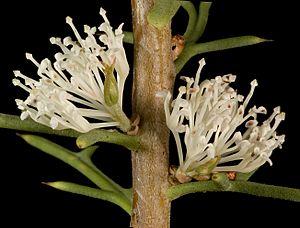Variable-leaved hakea facts for kids
Quick facts for kids Variable-leaved hakea |
|
|---|---|
 |
|
| Scientific classification | |
| Genus: |
Hakea
|
| Species: |
varia
|
Hakea varia, often called the variable-leaved hakea, is a type of shrub. It belongs to the Proteaceae plant family. This plant is special because it grows only in Western Australia. You can find it in areas like the Wheatbelt, South West, Great Southern, and Goldfields-Esperance regions. It's a dense, prickly bush. It has lovely creamy-white or yellow flowers. Its leaves are quite unique because they can have different shapes on the same plant.
Contents
What Does This Plant Look Like?
Hakea varia is a shrub that can grow straight up or spread out. It usually reaches a height of 1 to 4 metres (3 to 13 ft). It can also spread about 3 metres (10 ft wide). This plant has a special woody swelling at its base called a lignotuber. This helps it regrow after fires.
Leaves and Branches
The young branches and new leaves are covered in soft, silky hairs. These hairs soon disappear, leaving the plant smooth. The leaves are stiff and can vary a lot. Some leaves might be needle-shaped. Others might be simple, oval, or egg-shaped. They can also be toothed. The leaves are usually 1 to 4 centimetres (0.4 to 1.6 in) long. They are about 2 to 5 millimetres (0.08 to 0.2 in) wide. All these different leaf shapes always end in a sharp point. This point is about 1 to 2 millimetres (0.04 to 0.08 in) long.
Flowers and Fruit
The flowers of Hakea varia are very pretty. They are sweetly scented and come in white, cream, or yellow colours. They grow in clusters of 16 to 36 flowers. These clusters appear where the leaves meet the stem. The flower stalk is short, about 2.5 to 4 millimetres (0.1 to 0.2 in) long. It has rough, long hairs.
Small, overlapping leaf-like parts called bracts protect the flowers. These bracts are about 4.5 millimetres (0.2 in) long. The inner bracts have a rust colour. Each flower sits on a tiny stalk called a pedicel. These are 2 to 4 millimetres (0.08 to 0.2 in) long. The female part of the flower, the pistil, is 4 to 5 millimetres (0.16 to 0.2 in) long. The flower's outer parts, called the perianth, are white and 2.5 to 3.5 millimetres (0.1 to 0.14 in) long.
Hakea varia flowers from July to November. After flowering, it produces small, oval-shaped fruits. These fruits are rough, warty, or sometimes smooth. They are about 1.5 to 2 centimetres (0.6 to 0.8 in) long. They are usually less than 1 centimetre (0.4 in) wide. Each fruit ends with a sharp horn that curves outwards. This horn is about 3.5 millimetres (0.14 in) long.
How Did It Get Its Name?
The variable-leaved hakea was first officially described by a botanist named Robert Brown. He wrote about it in a scientific paper called Transactions of the Linnean Society of London.
Meaning of the Name
The name varia comes from the Latin word varius. This word means "variable" or "changing." This name was chosen because the plant's leaves can have many different shapes.
Where Does This Plant Grow?
Hakea varia is found in many places across Western Australia. It grows from areas north of Perth all the way along the coast. You can find it near towns like Augusta and Esperance.
Preferred Habitat
This plant likes places that get wet in winter. It can grow in different types of soil, including sand, clay, loam, and gravel. It can also handle frost. Hakea varia grows well in both sunny and shady spots. Because it's a dense and prickly shrub, it provides a good home for wildlife.
Is It Endangered?
The Western Australian Government's Department of Parks and Wildlife checks on the health of plants. They have classified Hakea varia as "not threatened." This means it is not currently in danger of disappearing.

